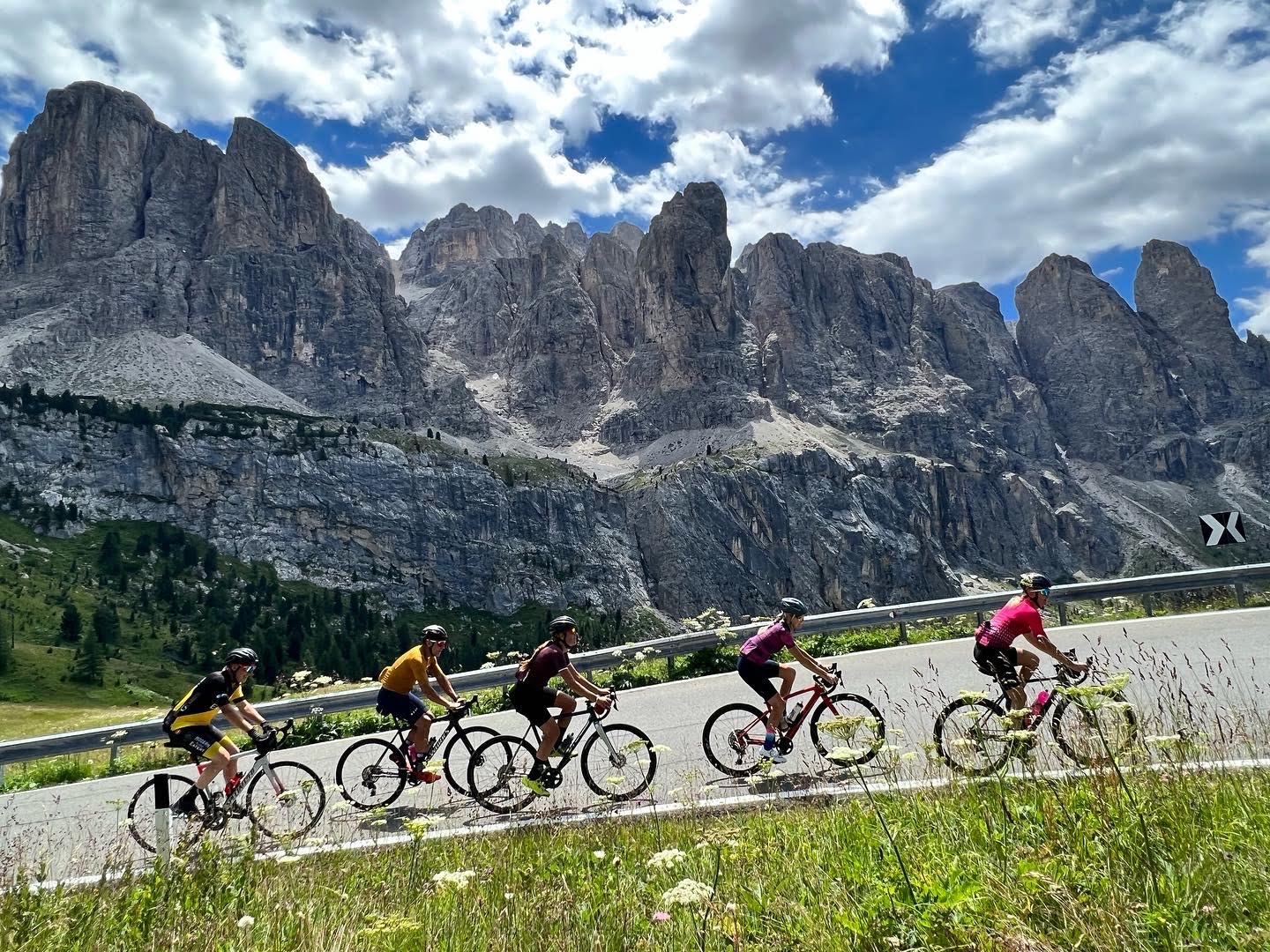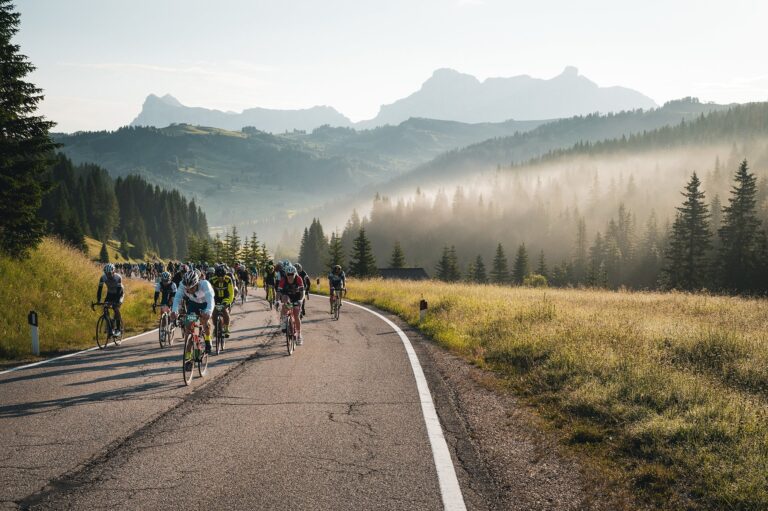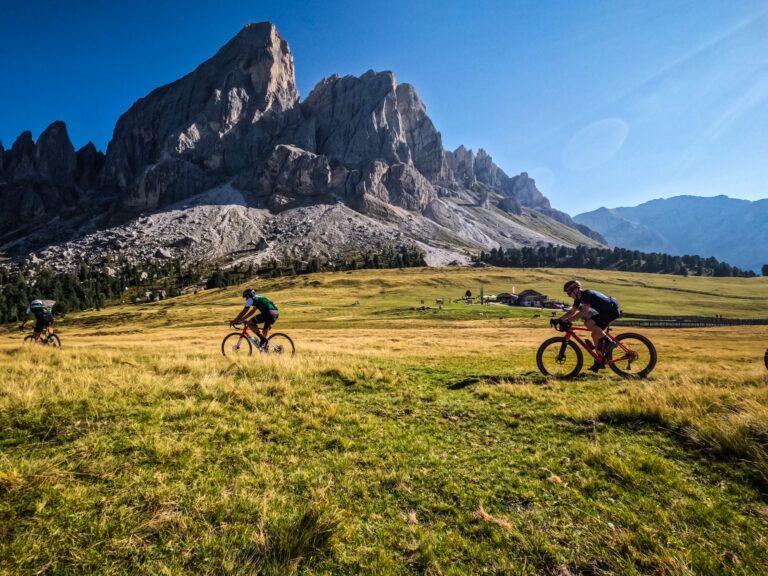Cycling the Four Passes of the Sellaronda
Inch for inch, the Sellaronda may be the most gorgeous bike ride in the world. Yes, it’s that spectacular. Not only that, it is of utmost historic importance, since each of the four passes (Passo Gardena, Passo Sella, Passo Pordoi, and Passo Compolongo) has been included in the route of the Giro d’Italia on countless occasions.
As an introduction to all the cycling routes the Dolomites have to offer, there is no other loop quite like the Sellaronda. It is, literally, a rite of passage for serious cyclists. The question isn’t whether to ride this loop as your appetizer for any Dolomites trip, but which direction to ride it: clockwise or counterclockwise.
Or let Alter Exploration decide. If you want the ultimate Sellaronda experience, or you want to include quiet roads on your itinerary, all this and more can be made part of your fully custom Secret Dolomiti Cycling Tour with Alter Exploration.
Riding the Sella Ronda is a rite of passage for serious cyclists.

Which Direction Should I Ride the Sellaronda?
In a word, both! But there are subtle differences between riding the loop in one direction versus the other. The Maratona dles Dolomiti takes in the Sellaronda in a clockwise direction. In this direction, you get to warm up on Passo Campolongo, the shortest and easiest of the four passes. Next comes the Pordoi, the biggest pass, which is gorgeous in any direction. Riding Pordoi second on the day helps with pacing the effort. Next comes Passo Sella, and finally Passo Gardena, before a descent into Corvara.
If you have time to ride in a counterclockwise manner, you’ll be treated to all new views! Let’s take a closer look at each of the four passes, as if you were riding counterclockwise.
Riding The Sellaronda Counterclockwise
Passo Gardena
Passo Gardena is the main connecting road between the Ladin valleys of Val Badia and Val Gardena. As such, it is one of the busiest passes of the Dolomites. In the morning you may encounter commuters driving to work, and herds of tourists or motorbikes throughout the day.
That said, the potential for it to be busy shouldn’t stop you from riding Passo Gardena. There are some good days and hours to ride, like during midday (between noon and 1:30 pm) when everyone usually has lunch. Or you can ride it during the Sellaronda Bike Day when all four passes (Gardena, Sella, Pordoi, Campolongo) are closed to motorized vehicles.
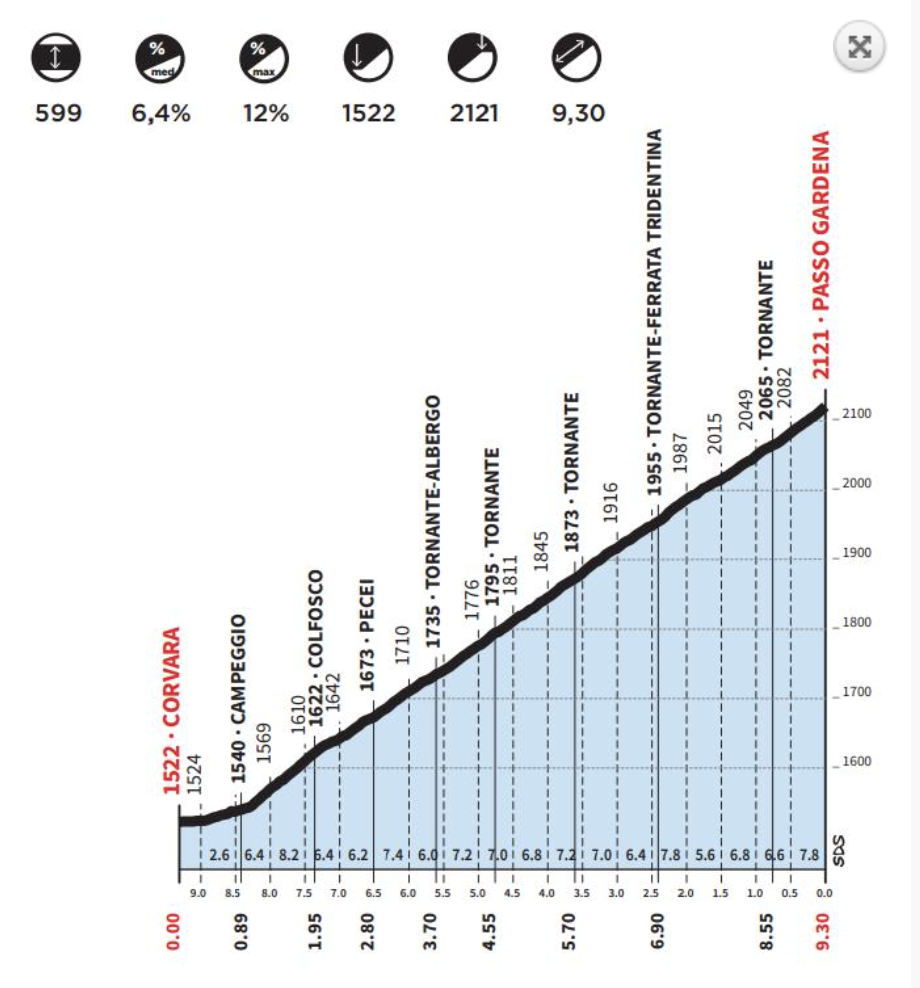
If you’re riding Sellaronda in a counterclockwise direction, the climb starts in Corvara, and you quickly reach the town of Colfosco. Here the gradient is around 8-9%. As soon as you enter the town, the road gets even steeper. As soon as you leave Colfosco behind, the first hairpins begin. With each successive hairpin, the straights in between get shorter, until you see all the hairpins stacked above you.
After 5.6 kilometers into the climb (and around 3.5 kilometers from the top), the road grade is always above 10%. If you ride this stretch in early spring, beware of gravel, cracks, and potholes in the road. Typically, winter landslides drop debris and tear up the road surface—and the road needs to get repaired once the snow melts in spring. Riding uphill won’t give you any problems, but pay careful attention while descending.
With about 3 kilometers to go, you will spot the hut at the top of the climb. You’re almost there. Once you reach the top, be prepared to be floored, as the view of the majestic Sassolungo rises up in front of you.
If you’re going for time, you’ll immediately start barreling down to one of the most gorgeous stretches of road, just feet away from the sheer wall of the Sella Massif. If you’re not in a hurry, stop at the cafe and grab a cappuccino and a piece of apple strudel.
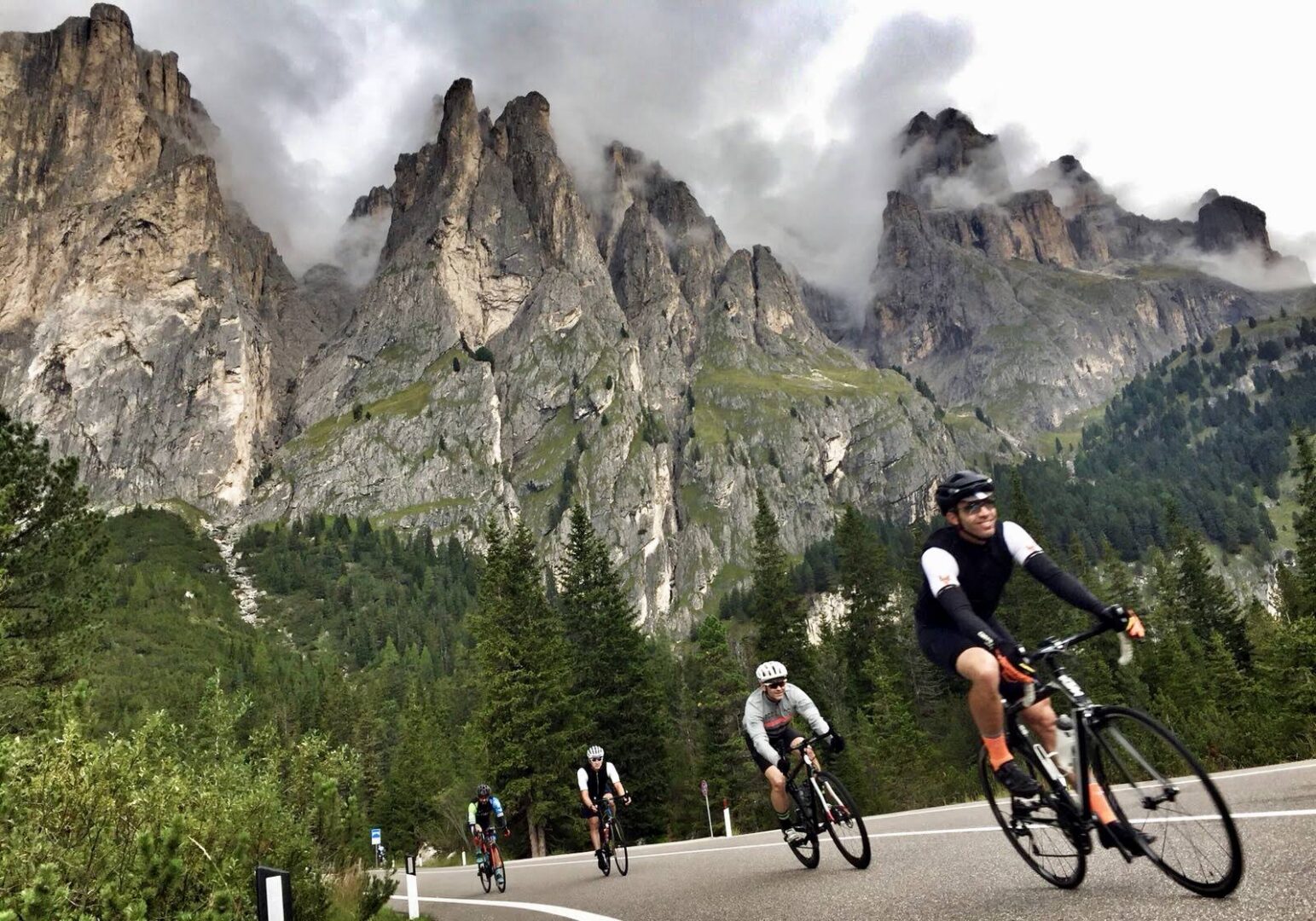
Passo Sella
Passo Sella is nonstop majesty. If you’re riding clockwise, directly in front of you are the walls of the Sella Massif; but look around and you will see more and more of Italy’s famous Marmolada glacier the higher you climb. Once you’re out of the forest, on the final hairpins, you’ll begin to see the magnificent Sassolungo mountain peaks, aka the Langkofel.
If you’re riding with a group, the last hairpins are where you’d be able to take some of the best photos of you and your friends. All the ingredients of a great cycling photo come together: the beautiful curves of the hairpin corners and the magnificent view of the sheer limestone walls. If you wait to get your photo at the top of the climb, it may be too late and you’ll find yourself in the midst of cars and motorbikes.
The Sella reaches a maximum gradient of 12% in three places. At 1.2 km from the start (of the south side), things get serious. The Sella is a little different from the other climbs because it doesn’t have a steady gradient. There are sections that are between 5 to 7%, then quickly it might become a 10% wall after a hairpin. Luckily, it’s short—only 4.5 km. So dare to look above you, and you’ll see that you’re right under the Sella Massif walls—you get nearest to these amazing cliffs on the Sella.
Passo Pordoi
Climbing Passo Pordoi from the village of Arabba is like taking an escalator to the heavens. The even grade never goes above 7%—it’s just a straight upward trajectory from Arabba to the top of the Pordoi.
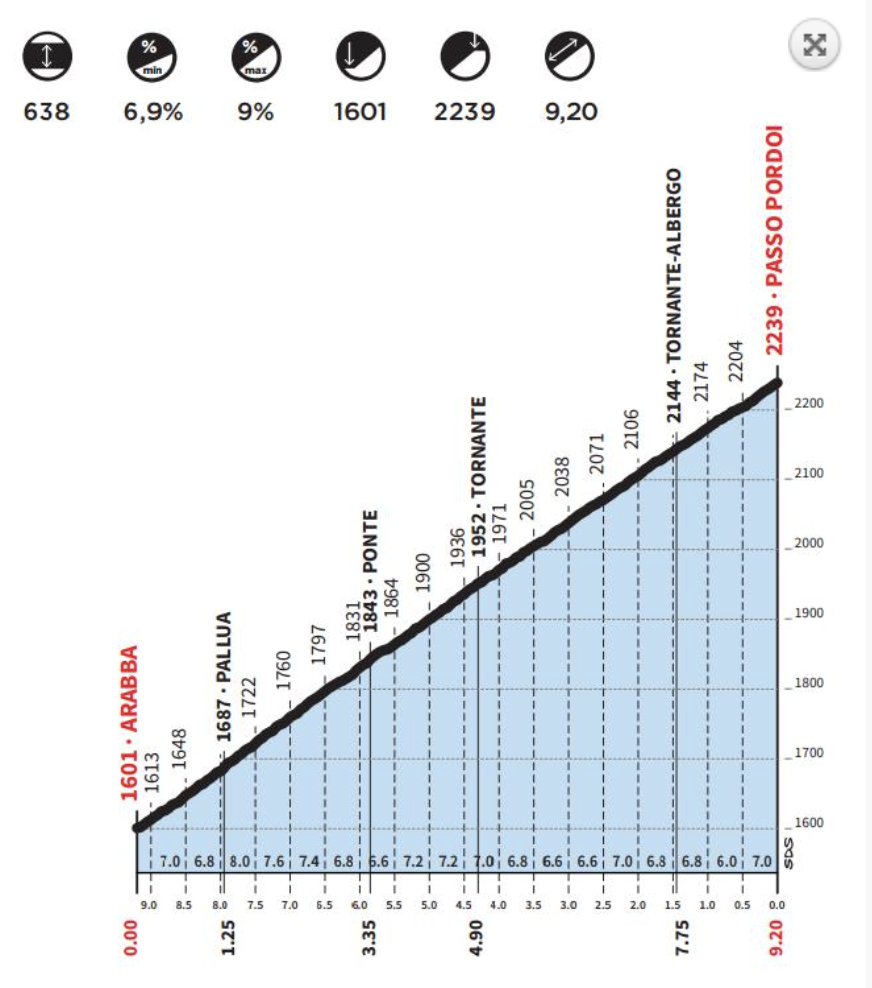
Soon after you leave Arabba, it’s lush green pastures and some shrubs here and there. There are no trees to disrupt the iconic views to the north. But beware the potential for wind. For the first 3.5 km of the Pordoi, you have only four series of hairpins, with a few long straights in between.
After those opening kilometers, the real fun begins: 22 hairpins in 4.5 km! This is an average of one hairpin every 200 meters.
“It’s like a rollercoaster, only that you don’t use the force of gravity to reach the next hairpin—you fight against it,” says local legend Igor Tavella, whose family runs Ustaria Posta, the small hotel that I often stay at. “If you ride this route in low season, you’ll hear whistling. These are your fans: marmots! On early morning or late afternoon rides, you might see them crossing the road right in front of your wheels.”
At the pass, look for the statue of Fausto Coppi, Il Campionissimo, the legendary Italian cyclist and five-time winner of the Giro d’Italia. To this day, the Cima Coppi, or highest point reached on the Giro route, is named after the Piedmont-born Coppi.

Passo Campolongo
The Campolongo is considered by most cyclists as the easiest and least attractive of the Sellaronda climbs. It’s one of the lowest climbs in the Dolomites with an altitude of only 1,875 meters.
Still, the Campolongo has something to offer. For starters, this is the best pass if you want to practice how to ride hairpins and improve your downhill skills.
While most Dolomite passes have flat or nearly-flat hairpins, the first part of the Campolongo is just the opposite. The straights aren’t that steep but the hairpins are very steep!
On the Corvara side of the Campolongo lies a permanent landslide—it creeps along at a few centimeters a year. Each spring, the road gets shredded, so wait until around mid-June (shortly before the Maratona dles Dolomites) for repairs to be completed.
Sellaronda MTB: Riding the Sella Massif on a Mountain Bike
For those looking to get away from pavement, there is another version of the Sellronda, completely off road. With mountain bikes and a series of lifts, you can circumnavigate the Sella Massif on trails and with far less elevation gain. There are two versions of the Sellaronda MTB Tour. One runs clockwise for 58 kilometers and with 450 meters of elevation gain, and the other runs counterclockwise for 53 kilometers and 900 meters of gain.
Again, it’s a toss-up as to which direction is better to ride in. Going counterclockwise is the more challenging and technical variant. However, being able to pedal beneath the Sassolungo peak, passing by the Città dei Sassi, makes for a spectacular experience.
Going clockwise is a more gentle yet equally fascinating version. From Corvara, you climb through the magnificent Pralongià high plateau before descending to Arabba in the province of Belluno, then onto Pordoi, Sella, and Gardena.
Either route is a once-in-a-lifetime experience.
See more about the destination and our fully custom itineraries.


